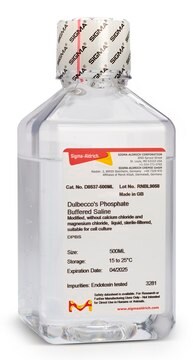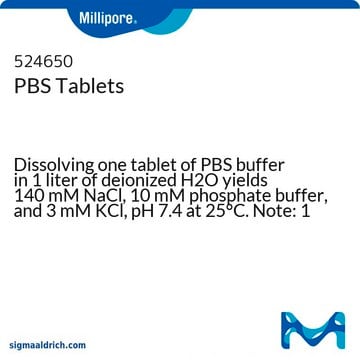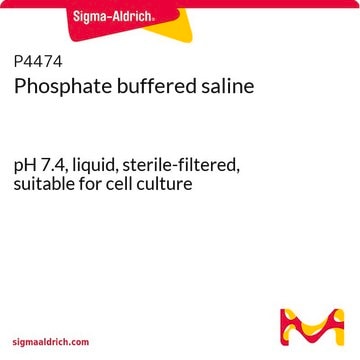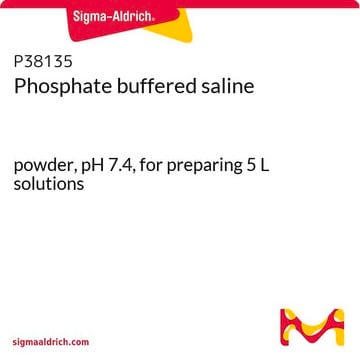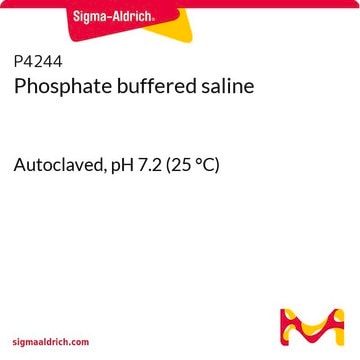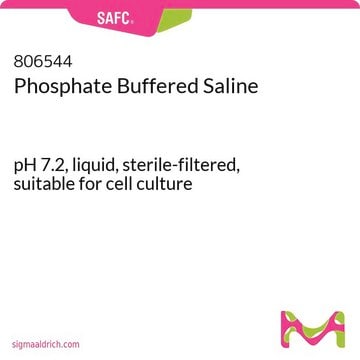Products may be shipped at a different temperature than the recommended long-term storage temperature. If the product quality is sensitive to short-term exposure to conditions other than the recommended long-term storage, it will be shipped on wet or dry-ice. If the product quality is NOT affected by short-term exposure to conditions other than the recommended long-term storage, it will be shipped at ambient temperature. As shipping routes are configured for minimum transit times, shipping at ambient temperature helps control shipping costs for our customers. For more information, please refer to the Storage and Transport Conditions document: https://www.sigmaaldrich.com/deepweb/assets/sigmaaldrich/marketing/global/documents/316/622/storage-transport-conditions-mk.pdf
P3813
Solution tampon phosphate
powder, pH 7.4, for preparing 1 L solutions
Synonyme(s) :
PBS
Sélectionner une taille de conditionnement
18,10 €
Sélectionner une taille de conditionnement
About This Item
18,10 €
Produits recommandés
Nom du produit
Solution tampon phosphate, powder, pH 7.4, for preparing 1 L solutions
Niveau de qualité
Forme
powder
Conditions de stockage
dry at room temperature
Couleur
white
pH
7.4
Solubilité
water: soluble
Densité
1.19 g/cm3 at 20—25 °C
1.22 g/cm3 at 20—25 °C
Application(s)
diagnostic assay manufacturing
life science and biopharma
sample preparation
Vous recherchez des produits similaires ? Visite Guide de comparaison des produits
Description générale
Le pouvoir tampon du PBS, assuré par l'équilibre phosphate-acide phosphorique, crée un environnement de pH stable crucial pour optimiser l'activité des enzymes et divers processus biologiques. Le PBS est donc un choix idéal pour la préparation de réactifs, la dialyse de protéines et l'immunohistochimie, garantissant des résultats expérimentaux reproductibles et fiables. Outre la biologie cellulaire, le PBS peut aussi être utilisé dans divers autres domaines comme la création de tampons ELISA sur mesure pour optimiser les interactions anticorps-antigène. Il peut aussi servir de tampon de migration pour la chromatographie d'affinité avec protéine A/G, facilitant la purification des anticorps en se basant sur leur liaison à un antigène spécifique. En hématologie et en biochimie, le PBS est fréquemment employé pour laver les cellules et les tissus.
En résumé, le PBS se démarque comme un outil indispensable tant dans la recherche en biologie qu'en biochimie, garantissant isotonicité, pouvoir tampon, simplicité et stabilité. Ses différentes applications en biologie cellulaire, dans la préparation de réactifs, la purification de protéines et divers tests biologiques montrent à quel point il fait progresser les connaissances scientifiques et notre compréhension.
Application
- dans les solutions de lavage d'une procédure d'immunofluorescence[1].
- pour mettre en suspension des cellules bactériennes[2].
- durant des procédures de fixation et d'immunocoloration[3].
- pour rincer des tissus fixés et créer un environnement tampon adapté dans un procédé d'immunolocalisation[4].
- comme diluant pour évaluer les performances d'un kit de test ELISA[5].
- comme tampon dans une procédure d'immunohistochimie.[6][3]
Caractéristiques et avantages
- Produit de grande qualité convenant à de nombreuses applications de recherche.
- Peut être ajouté aux tampons de biologie et de biochimie.
- Forte solubilité dans l'eau.
Conditionnement
Reconstitution
Autres remarques
Code de la classe de stockage
13 - Non Combustible Solids
Classe de danger pour l'eau (WGK)
WGK 3
Point d'éclair (°F)
Not applicable
Point d'éclair (°C)
Not applicable
Faites votre choix parmi les versions les plus récentes :
Certificats d'analyse (COA)
Vous ne trouvez pas la bonne version ?
Si vous avez besoin d'une version particulière, vous pouvez rechercher un certificat spécifique par le numéro de lot.
Déjà en possession de ce produit ?
Retrouvez la documentation relative aux produits que vous avez récemment achetés dans la Bibliothèque de documents.
Les clients ont également consulté
Articles
This is a protocol for a Membrane Integrity test for Lipid-PAMPA Artificial Membranes
Protocoles
ICC Cell Capture Imaging Reagent simplifies imaging, ideal for rare cell and low cell count samples.
Cell staining can be divided into four steps: cell preparation, fixation, application of antibody, and evaluation.
Assays that predict passive absorption of orally administered drugs have become increasingly important in the drug discovery process. As previously described by Faller and Kansy such assays provide rapid, low cost and automation friendly methods to measure a compound’s passive permeability.
Strat-M® synthetic membrane mimics the human skin for In-vitro permeation testing (IVPT) of topical and transdermal formulations
-
How is shipping temperature determined? And how is it related to the product storage temperature?
1 answer-
Helpful?
-
-
How can I determine the shelf life / expiration / retest date of this product?
1 answer-
If this product has an expiration or retest date, it will be shown on the Certificate of Analysis (COA, CofA). If there is no retest or expiration date listed on the product's COA, we do not have suitable stability data to determine a shelf life. For these products, the only date on the COA will be the release date; a retest, expiration, or use-by-date will not be displayed.
For all products, we recommend handling per defined conditions as printed in our product literature and website product descriptions. We recommend that products should be routinely inspected by customers to ensure they perform as expected.
For products without retest or expiration dates, our standard warranty of 1 year from the date of shipment is applicable.
For more information, please refer to the Product Dating Information document: https://www.sigmaaldrich.com/deepweb/assets/sigmaaldrich/marketing/global/documents/449/386/product-dating-information-mk.pdfHelpful?
-
-
Is autoclaving necessary for PBS P3813 before conducting the presence-absence test for coliform bacteria?
1 answer-
No, phosphate buffers by themselves are generally not autoclaved due to the common occurrence of precipitate formation. Autoclaving is commonly used in microbiology, but if your test method only requires sterilization without specifying autoclaving, filter sterilization might be a better option to consider.
Helpful?
-
-
Does P3813 PBS (Phosphate Buffered Saline) contain calcium or magnesium?
1 answer-
The composition of P3813 PBS Phosphate Buffered Saline is considered proprietary, but the website provides the following information. When one pouch is dissolved in one liter of distilled or deionized water, it yields 0.01 M phosphate buffered saline with a pH of 7.4 at 25°C, consisting of NaCl at 0.138 M and KCl at 0.0027 M.
Helpful?
-
-
Good morning, I would like to know what PKG means in kg. I would also like information about the validity of the solution resulting from the dissolution of the solid in question. Thanks
1 answer-
PKG means package. One package is one pouch. As per its COA: https://www.sigmaaldrich.com/certificates/sapfs/PROD/sap/certificate_pdfs/COFA/Q14/P3813-1PAK0000291289.pdf, each pouch contains 9.07-10.00 g of powder. And the pH and dissolution time are tested to validate the solution.
Helpful?
-
-
hi, what kg is in one package?
1 answer-
The amount of powder to prepare 1 liter of buffer is approximately 9.55 grams.
Helpful?
-
-
Does this PBS contain Ca and Mg?
1 answer-
No, the components of this formulation do not include calcium or magnesium.
Helpful?
-
-
What is the salinity of Phosphate buffer saline P3813?
1 answer-
As mentioned on the product detail page, the contents of one pouch, when dissolved in one liter of distilled or deionized water, will yield 0.01 M phosphate buffered saline (NaCl 0.138 M; KCl - 0.0027 M); pH 7.4, at 25 °C.
Helpful?
-
-
How long can solutions of Product P3813, Phosphate buffered saline, be kept once prepared?
1 answer-
Sigma Aldrich has not evaluated the solution stability, but sterile solutions of PBS stored at 2-8°C can be expected to be stable for several months.
Helpful?
-
-
How much is in each pouch of Product P3813, Phosphate buffered saline?
1 answer-
Each pouch of phosphate buffered saline contains 8 g sodium chloride (e.g. Product No. S9625), 0.2 g potassium phosphate, monobasic (e.g. Product No. P5379), 1.15 g sodium phosphate, dibasic (e.g. Product No. S0876), 0.2 g potassium chloride (e.g. Product No. P4504), giving a total 9.55 g per packet. This is the standard PBS formulation.
Helpful?
-
Active Filters
Notre équipe de scientifiques dispose d'une expérience dans tous les secteurs de la recherche, notamment en sciences de la vie, science des matériaux, synthèse chimique, chromatographie, analyse et dans de nombreux autres domaines..
Contacter notre Service technique
